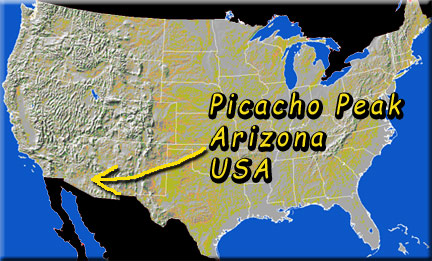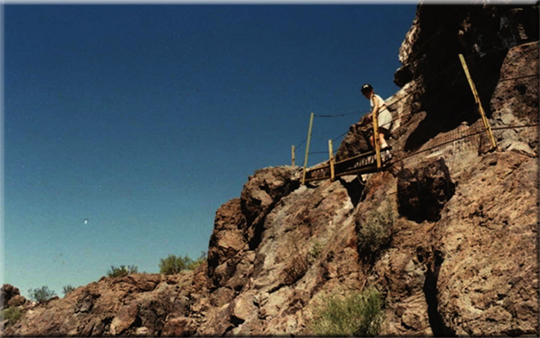|
 Is There A Water Fountain on Picacho Peak?by Mary Peirce Bale
Local newspapers promote places such as Picacho Peak State Park as getaways from city life because they offer open spaces of color, vistas, and wildlife. Picacho Peak State Park is renowned for its lupines, brittlebush, and poppies as well as challenging hiking trails up the peak which thrusts out of the flat desert floor. I can attest to the latter since I participated on a tramp up the peak where I almost died. It was a cool, pleasant, Saturday morning in mid October the day my husband, some friends and I chose to climb Picacho Peak located just off of I10 about 60 miles southeast of Phoenix in Casa Grande. This peak has historical significance because the Confederates, led by Captain Sherod Hunter, eked out a victory over the Union Forces killing Lieutenant Barrett during one of the Southwest's Civil War battles in April of 1862. There is an annual enactment of the battle on the site. Our expedition to the top of Picacho Peak would almost cause my demise during the Bale trek of 1989 because of my battle with oppressive heat, exhaustion, and lack of sufficient water.
The hike to the summit took three hours. It seemed like an eternity as I maneuvered my weary, sweaty body up steep inclines, around narrow ledges and grasped thick cables secured to boulders to steady me on the treacherous catwalks. My husband and his companions handled all these encumbrances without too much effort while I struggled with each step. After one of the numerous rest stops, backed up against the harsh granite, I heard the sound of an army unit's hup, two, three, four, hup, two, three, four ring in my ears as the troops trotted up the mountainside with ease. One recruit had some problems with the heat and his comrades had to rescue him, which made me feel a bit better about my own lack of fitness. One time I became daring as I perched precariously on a rock overhang for a prize-winning photograph. There had to be proof that at age 45 I had completed and survived the boot camp climb to the top of Picacho Peak.  As we ascended, mesmerizing vistas of the surrounding mountains and valleys broadened before my eyes, encouraging me to push onward and upward. When we reached the pinnacle, I managed to sign my name in the logbook that was kept in a tiny A-frame house the Park Service had provided before I collapsed into my husband's supportive arms. After I caught my breath, I noted there were many other courageous climbers milling around yelling out accolades for performing the feat. Every time a hiker appeared on the peak spontaneous cheers and applause erupted. Then cameras clicked away to record these triumphant moments of our lives. Amidst all this merriment dread crept over me when I realized there were no water jugs or water fountains up here only rock, dirt, and raw exposure to the sun. "How would I every make it back down the 1500' in the sweltering heat with my miniscule water supply?"
My husband tugged at me and said, "Let's go." I nodded as I dragged myself to the catwalk obstacles for the long descent. I felt as if I were outside of my body watching this woman stumble trying to regain her momentum. My husband was quite concerned about my condition, so he pulled me to a semi-shaded spot beside a huge rock. My eyes rolled around in my head and I was foaming at the mouth. He wanted to go for help but he dare not leave me alone. So he hoisted me on his back like a soldier wounded in battle and trudged along the trail for a quarter mile or more. When we hit the lower elevations I revived somewhat since I knew we would be on level ground soon where a water fountain would miraculously spurt out the life-saving manna. My husband cautioned me to take small sips of water for a bit as I walked to the water source. Just down the road from the Picacho Peak State Park entrance was the park store where we purchased Gatorade that I drank on the ride home. After two days in bed plied with plenty of water I was energized and thankful to be alive.
Mary says: During my 15 years in Arizona my husband and I
did a lot of off road travel in some of the most
scenic yet at times pristine areas. I just had to put
pen to paper and write about our unique adventures.
The fact that some of my articles were published You can contact her at mary_poetgal@yahoo.com.
©September 2005, Mary Peirce Bale
Further Information:
Now available as regional guides for your glovebox:

Mary was extremely lucky! Unfortunately, her experience is not uncommon. Every year, hundreds of people suffer heat exhaustion or heat stroke while hiking or exerting themselves in extreme temperatures. Anyone spending much time outdoors in summer should take a few simple precautions to ensure they don't become a statistic.

Be informed when this site is updated: |